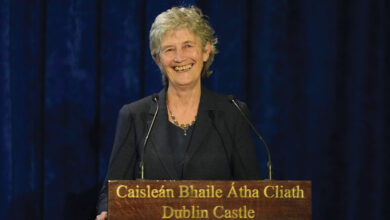Jim Fitzpatrick 1929-2022

Jim Fitzpatrick, as chair of The Irish News, played an unassuming yet crucial role in journalism and political life in Northern Ireland. Aged 92, Fitzpatrick’s life spanned the entirety of ‘the Troubles’ and the peace process.
Having entered the seminary with the intention of becoming a Redemptorist priest, Fitzpatrick changed his mind and qualified as a solicitor, where he worked for the family law firm in College Square North in Belfast.
The outbreak of ‘the Troubles’ heightened Fitzpatrick’s interest in journalism and public affairs, motivating him to enrol in a night-course in journalism, subsequently writing articles and conducting interviews for The Irish News.
Fitzpatrick was appointed as a director of The Irish News in 1969, and his political outlook, which was similar to that of the late former SDLP leader John Hume, proved crucial in the editorial line espoused by the newspaper throughout the conflict and subsequent peace process, including his guidance on the terminology used in IRA death notices during the conflict.
He assumed the role of managing editor of The Irish News in 1981, following the tragic death of his predecessor Daniel ‘Dinty’ McSparron and his sister Mary. He also later became chair of the paper.
Fitzpatrick retained a relationship with the Redemptorist Order and, in particular, Gerry Reynolds. His relationship with him and others at Clonard Monastery proved to be a crucial factor in efforts to establish dialogue between John Hume and Gerry Adams, talks which would become the crucial building blocks of the Good Friday Agreement.
Taoiseach Micheál Martin TD paid tribute to Fitzpatrick, remarking: “In his quiet and ceaseless philanthropy over a lifetime, his generosity has left its stamp all across Belfast and further afield.”
Sinn Féin vice-president Michelle O’Neill MLA said Fitzpatrick was a “quiet diplomat who worked to advance and influence peace and reconciliation across the political divide”.
SDLP leader Colum Eastwood MP described Fitzpatrick as “full of integrity and unfailingly kind”, further reflecting that “he will be missed by everyone who knew him”.
Jim Fitzpatrick died on June 25 after a short illness. Predeceased by his wife Alice in 2013, he is survived by their children Anne, Bríd, Bernard, Eileen, Dominic, Clare, Jim, and Andrew as well as 26 grandchildren, and his sisters Anne and Dympna.
Ar dheis Dé go raibh a anam.





